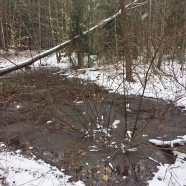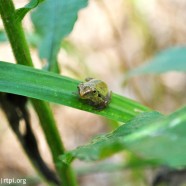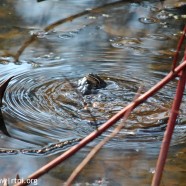Winter’s Not Over Yet
The fresh blanket of snow across the Western New York landscape is a good reminder that winter isn’t over just yet. However, some of our resident amphibians have been receiving crossed signals due to recent increases in daylight hours and above average temperatures; we have actually gotten reports of salamanders and frogs moving to nearby ponds and vernal pools to lay their eggs. With this weekend’s dropping temperatures, local pools have started to ice over indicating freezing temperatures near the surface. The eggs of some amphibian species are able to cope with fluctuating spring...
Read MorePeepers Peeping
Have you heard the Spring Peepers calling lately? These little frogs seem to be a bit confused as breeding season was over months ago! Although we are entering autumn and the frogs will soon be going into torpor (an amphibian’s form of hibernation), the current conditions closely mimic ideal breeding conditions in the spring. Low overnight temperatures, warm days, more frequent rainfall and a similar photo-period send the signal to the males to belt out their loud, high-pitched peeps in hopes of attracting some females. However, these little males will be disappointed pretty quickly as...
Read MorePurple Martins (Progne subis)
Placed along a number of yards and marinas along Chautauqua Lake, these gourds create little neighborhoods for a number of nesting Purple Martins (Progne subis). During the breeding season, Purple Martins will take up residence in these man-made houses to safely nest and raise their young. As the little ones begin to hatch and grow, both the male and female will collect bug food to bring back to them. These large aerial insectivores are incredibly acrobatic and able to turn on a dime in order to pursue a fleeing insect. This summer season, no bug will be safe while the Purple Martins are in...
Read MoreProductive Vernal Pools
Have you ever wondered what might be hiding just beneath the water’s surface in these temporary pools that crop up in early spring? This little clip reveals a productive vernal pool that has a number of spotted salamander (Ambystoma maculatum) egg masses nestled within the leaf litter of the pool floor. These pools are an important breeding area for several amphibian species, as you can see, because they provide a safe fish-less environment for the eggs and eventual tadpoles to...
Read MoreMale Competition
The Wood Frog (Rana sylvatica) is another early spring breeding amphibian common to our region. These explosive breeders utilize vernal pools, just like spotted salamanders, and their breeding activities are squeezed into just a few days. As the frogs enter the pools, males will take up their positions floating at the surface of the pool croaking their characteristic call. While they are calling, they will often joust with one another, especially if a female is nearby. These two males had a bit of a tousle, but both went on to call in another spot ready for females to come their way. Elyse...
Read More








